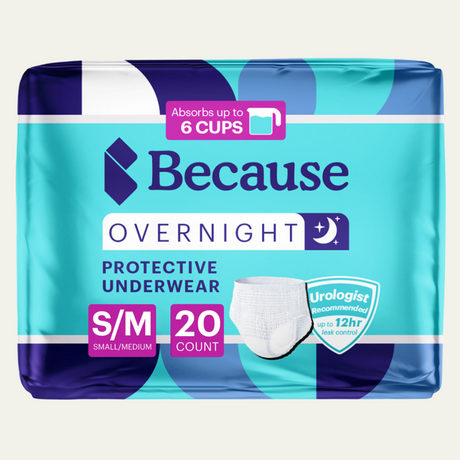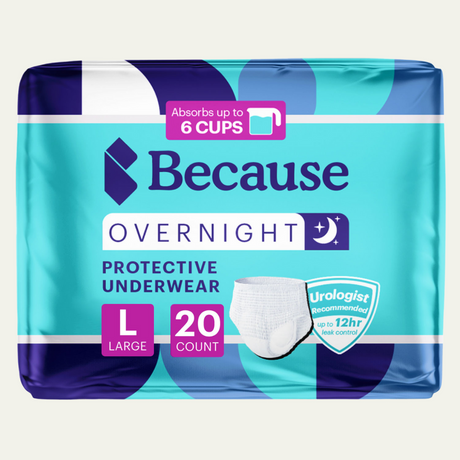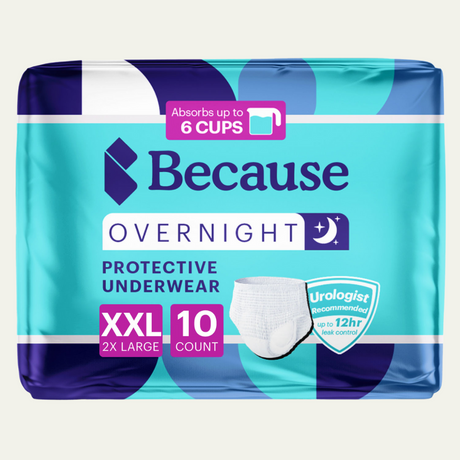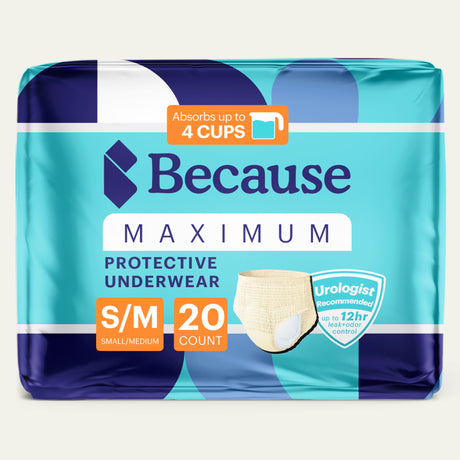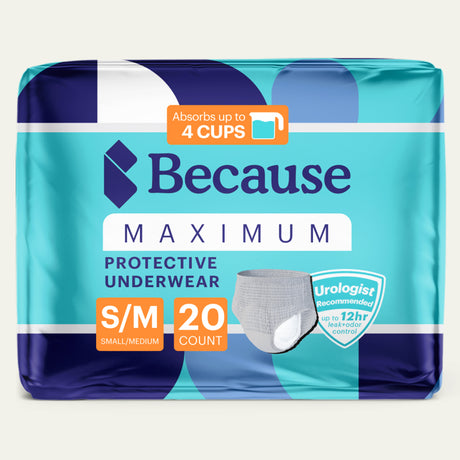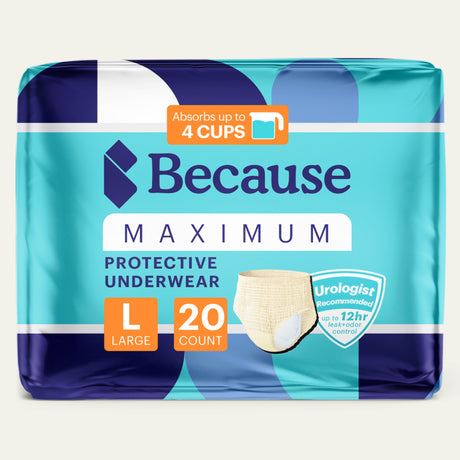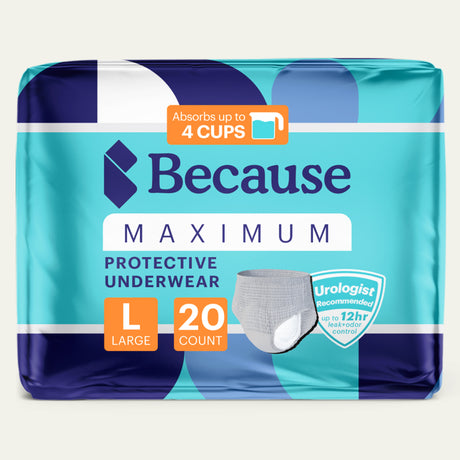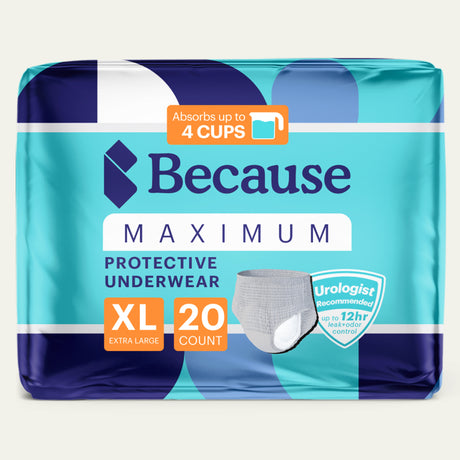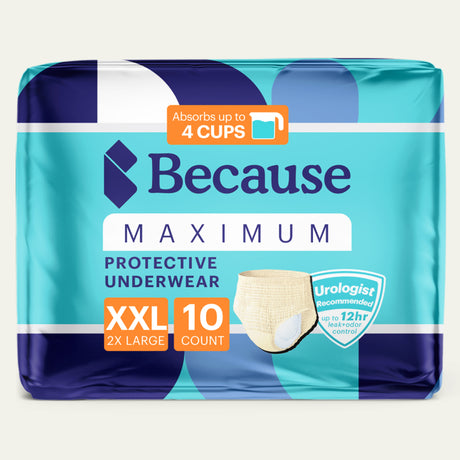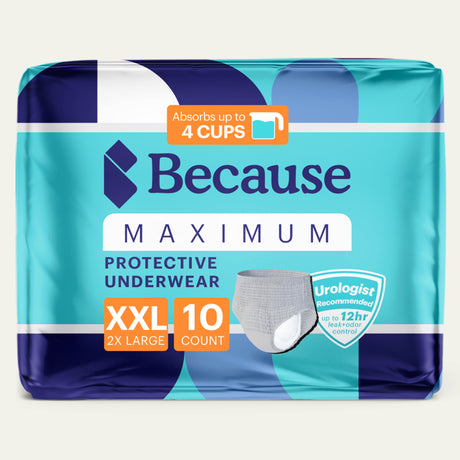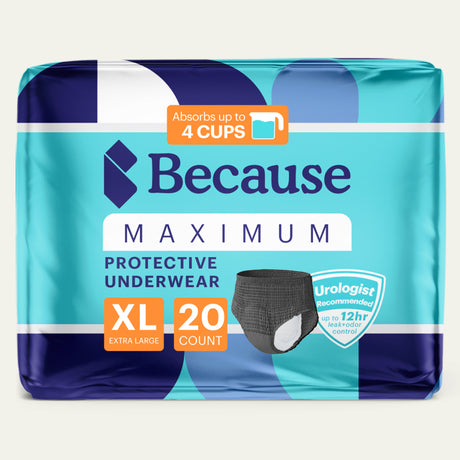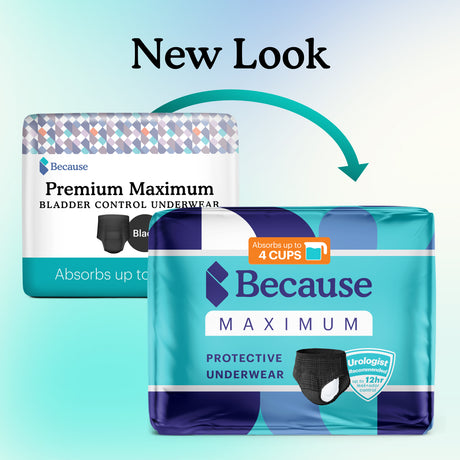Medically reviewed by Dr. Kerac Falk, MD, FACOG.
Around half of all adult women and as much as 34% of adult men deal with urinary incontinence. The good news is there are treatments available that can reduce urine leakage and other symptoms of bladder control problems. Double voiding is one potential behavioral management technique for incontinence, and in this guide, we’ll explain what it is, how it helps, and the correct method for performing it.
What Is Double Voiding?
Although its name may seem technical, double voiding is actually simple. The term refers to trying to urinate a second time when you go to the bathroom. Doing so can help the bladder empty more fully.

The Importance of Bladder Emptying
Urinating helps flush microorganisms out of the bladder and urethra. If the bladder doesn’t empty properly, bacteria can sometimes build up and give rise to urinary tract infections.
Over time, incomplete bladder emptying can also make it more difficult for the bladder muscle to function properly. In severe cases, pressure buildup due to urine can cause bladder and/or kidney damage.
Voiding dysfunction that results in incomplete emptying can also make some types of urinary incontinence more likely to occur. If the bladder never fully empties, there is less room for more urine, leading to urinary frequency and overactivity. If the bladder becomes so full that urine leaks out, a person may develop overflow incontinence.
Benefits of Double Voiding
As previously mentioned, double voiding helps the bladder empty fully and can provide some short and long-term benefits as a result.
Reducing the Symptoms of Overactive Bladder and Other Types of Incontinence
Employing double voiding techniques may help to reduce symptoms of some types of incontinence, including:
- Overactive bladder (OAB): In people with OAB, the bladder contracts abnormally, leading to urinary frequency and urgency. Double voiding may cut down urinary urgency and frequency by providing more time for the bladder to empty when you use the restroom.
- Stress urinary incontinence: This type of incontinence occurs when the pelvic floor muscles that support the bladder become weak, allowing urine to leak out when you cough, exercise, lift heavy objects, laugh, sneeze, and do other tasks that apply pressure to the abdomen. Double voiding helps you pass the full amount of urine in your bladder, so there is less chance for leaks.
- Overflow incontinence: Ensuring that the bladder empties more fully with double voiding can reduce the risk of leakage and loss of bladder control due to overflow incontinence.
Reducing Urinary Tract Infections
We already established that emptying your bladder fully when you use the restroom can help reduce the risk of an infection. Double voiding is a way to more fully empty your bladder and can play a role in UTI prevention as a result.
Who Should Try Double Voiding?
Double voiding is unlikely to be harmful, so it’s a strategy that anyone can employ. However, healthcare providers are most likely to recommend it to patients who have:
- OAB, overflow incontinence, or stress incontinence
- A history of recurring UTIs
- Pelvic organ prolapse, which is when the pelvic organs press against or drop out of the vagina, potentially making it difficult to urinate
- Benign prostatic hyperplasia (enlarged prostate), which can cause voiding dysfunction in men
- Another medical condition that makes it difficult to fully empty the bladder
How to Double Void
To try double voiding, follow these steps.
Preparing for the Process
Being able to fully relax is important for double voiding. If you tend to rush through the process, try taking a few deep breaths to slow yourself down. Some people find that the sound of running water assists with urination, so you may want to consider turning on the sink faucet.
Body Positioning
Women should avoid crouching and hovering over the toilet seat, and men should try sitting rather than standing to encourage full bladder emptying.
Get comfortable on the toilet. Sit down fully on the toilet seat and relax your muscles.
Initial Void
As you urinate, keep your muscles as relaxed as possible. Don’t try to slow or stop the stream. Just allow urine to flow freely.
Pause
Wait for 15 to 45 seconds. During this period, you can try moving around by leaning forward and then sitting up straight and/or shifting from side to side. Some people may prefer getting up, walking around, and then sitting down again. Do whatever feels most natural to you.
Second Attempt
After the pause, try to urinate again. When you feel like your bladder is empty, give one final push by thrusting out your belly and holding it for a few seconds.

Frequently Asked Questions About Double Voiding
For more information about how to approach double voiding, check out these answers to frequently asked questions about the topic.
When Should You Consult Your Doctor About Bladder Leakage?
It’s never too soon to talk to your healthcare provider about incontinence concerns. A urologist, urogynecologist, or other medical provider can discuss your symptoms with you and help you explore other treatment options like medications or procedural treatments.
How Often Should You Double Void?
There is no set number of times per day that you should double void. Just get in the habit of double voiding every time that you go to the bathroom.
Your healthcare provider can give you specific advice about how many times per day you should be urinating.
What Is Timed Voiding?
Timed voiding or bladder training is the process of taking regularly scheduled trips to the bathroom to urinate, even when you don’t have the urge to go. Over a period of weeks and months, your bladder can begin to adjust to the routine, potentially decreasing urinary urgency and leakage.
Double voiding can be used in conjunction with timed voiding. To do so, you’d simply perform the steps for double voiding during each scheduled void.

Strategies to Complement Double Voiding
Spending a few minutes in the bathroom to double void is usually just one part of a conservative treatment plan for urinary incontinence. The following are some things that you can do to complement double voiding.
Diet and Lifestyle Changes
Making changes to your diet and overall lifestyle can help you better manage incontinence. To do so, follow these tips:
- Stay hydrated by drinking the amount of fluid your doctor recommends each day.
- Eat a high-fiber diet to reduce the risk of constipation, which can cause urinary retention.
- Cut back on foods and drinks that are known bladder irritants, such as caffeinated beverages, acidic foods, artificial sweeteners, spicy foods, and fried foods.
- Limit your intake of alcohol.
- Stop smoking.
- Reach or maintain a healthy weight with diet and exercise, as obesity can increase the risk of incontinence.
Bladder Control Exercises
Pelvic floor exercises can help strengthen the muscles that support the bladder and lower the likelihood of urine leakage. One of the most common exercises is the Kegel, which involves tightening the pelvic floor muscles for a few seconds numerous times in a row. Sometimes training on how to relax muscles is more helpful to certain patients.
A physical therapist can help you identify the correct muscles to tighten or relax.
Incontinence Protection
Incontinence protection products like absorbent underwear and pads can help you stay dry when urine leaks occur. Products are available for men and women, and you can choose from moderate, maximum, and overnight absorbency levels, based on your needs.
Do you struggle with incontinence? Take our bladder protection quiz and get a sample pack to try.
If you're struggling with incontinence, join one of our private support groups today!
Women's Incontinence Support Group
Men's Incontinence Support Group
About the Expert:
Dr. Falk is a fellowship-trained urogynecology subspecialist, double board-certified in both Obstetrics and Gynecology, as well as Female Pelvic Medicine and Reconstructive Surgery. He has expertise in the treatment of female pelvic floor disorders, which encompass many common but infrequently-discussed conditions which significantly impact women’s quality of life. These include complex disorders such as urinary and bowel incontinence, pelvic organ prolapse, childbirth injury, genital fistulas, recurrent urinary tract infection, and bladder pain.
Sources:
Mayo Clinic Health System. (2022, Nov. 7.). Is Urine Incontinence Normal for Women? https://www.mayoclinichealthsystem.org/hometown-health/speaking-of-health/is-urine-incontinence-normal-for-women
Alrais, Mena. (2021). Urinary Incontinence in Men. U.S. Pharmacist. 46(6):4-9. https://www.uspharmacist.com/article/urinary-incontinence-in-men


